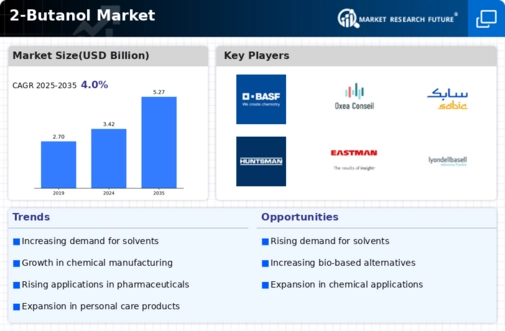Growth in Chemical Manufacturing
The 2-Butanol Market is significantly influenced by the expansion of chemical manufacturing processes. As a key intermediate in the production of various chemicals, including butyl acrylate and butyl acetate, 2-Butanol plays a crucial role in the synthesis of materials used in diverse applications. The chemical manufacturing sector has shown a steady growth rate of around 4% annually, which is anticipated to continue as demand for specialty chemicals rises. This growth is likely to enhance the utilization of 2-Butanol, thereby reinforcing its position within the market. The increasing complexity of chemical formulations may further stimulate the demand for 2-Butanol, contributing to the overall dynamics of the 2-Butanol Market.
Increasing Use in Solvent Applications
The 2-Butanol Market is experiencing a notable increase in demand for solvents across various sectors, including paints, coatings, and adhesives. This compound is favored for its ability to dissolve a wide range of substances, making it an ideal choice for manufacturers. In 2023, the solvent segment accounted for approximately 30% of the total market share, reflecting a growing trend towards the use of versatile solvents in industrial applications. As industries seek to enhance product performance and reduce environmental impact, the adoption of 2-Butanol as a solvent is likely to expand further. This trend is expected to drive innovation in formulation chemistry, thereby bolstering the overall growth of the 2-Butanol Market.
Regulatory Support for Chemical Safety
The 2-Butanol Market is positively impacted by increasing regulatory support aimed at ensuring chemical safety and environmental protection. Governments are implementing stricter regulations regarding the use of chemicals in various applications, which has led to a heightened focus on safer alternatives. 2-Butanol, being a relatively safer solvent compared to other organic solvents, is likely to benefit from these regulatory changes. The market for safer chemical alternatives is projected to grow, potentially increasing the demand for 2-Butanol in various sectors. This regulatory environment not only promotes the use of 2-Butanol but also encourages manufacturers to innovate and develop safer products, thereby enhancing the overall growth prospects of the 2-Butanol Market.
Advancements in Industrial Applications
The 2-Butanol Market is benefiting from advancements in industrial applications, particularly in the production of plastics and synthetic rubber. As industries evolve, the need for high-quality materials has prompted manufacturers to explore the use of 2-Butanol in various formulations. The plastics sector, for instance, has shown a robust growth trajectory, with an expected increase in demand for specialty plastics that utilize 2-Butanol as a processing aid. This trend is indicative of a broader shift towards enhancing material properties and performance, which is likely to further solidify the role of 2-Butanol in the market. The ongoing innovations in industrial applications are expected to drive the growth of the 2-Butanol Market.
Rising Demand in Personal Care Products
The 2-Butanol Market is witnessing a surge in demand from the personal care sector, where it is utilized as a solvent and a carrier for fragrances and active ingredients. The personal care industry has been growing at a compound annual growth rate of approximately 5% in recent years, driven by consumer preferences for innovative and effective products. As manufacturers seek to enhance product formulations, the incorporation of 2-Butanol is likely to increase, particularly in cosmetics and skincare products. This trend not only supports the growth of the 2-Butanol Market but also aligns with the broader movement towards high-performance personal care solutions.


















Leave a Comment